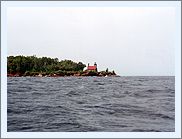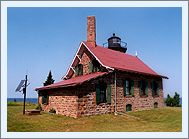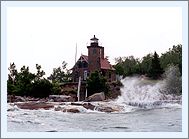|
Historical Information

Raspberry Island Lighthouse had been established in 1862 to serve
as a guide for eastbound vessels seeking entry into the channel between
the mainland and the  Apostle Islands which lead to the harbors of
LaPointe and Ashland. However, in practice its light was not visible to
mariners until they were fully abreast of Sand Island, from which an
underwater ridge with only 3 to seven feet of water stretched south to
the mainland. Soon after the establishment of light on Raspberry,
mariners began to call for a light on the north shore of Sand Island, to
better guide them toward Raspberry Island and the channel, and warn of
the dangerous ridge to the south. The Lighthouse Board heeded their call
in its 1871 annual report to Congress, requesting an appropriation of
$18,000 for the construction of a light on Sand Island. Although
Congress elected to ignore the request, convinced of the need for
lighting the island, the Board continued to restate its case in each of
its annual reports for the following six years. Congress finally
responded with the requested appropriation in 1880, and 11th District
Engineer Major Godfrey Weitzel set about planning for the station's
construction at the opening of the following navigation season. Apostle Islands which lead to the harbors of
LaPointe and Ashland. However, in practice its light was not visible to
mariners until they were fully abreast of Sand Island, from which an
underwater ridge with only 3 to seven feet of water stretched south to
the mainland. Soon after the establishment of light on Raspberry,
mariners began to call for a light on the north shore of Sand Island, to
better guide them toward Raspberry Island and the channel, and warn of
the dangerous ridge to the south. The Lighthouse Board heeded their call
in its 1871 annual report to Congress, requesting an appropriation of
$18,000 for the construction of a light on Sand Island. Although
Congress elected to ignore the request, convinced of the need for
lighting the island, the Board continued to restate its case in each of
its annual reports for the following six years. Congress finally
responded with the requested appropriation in 1880, and 11th District
Engineer Major Godfrey Weitzel set about planning for the station's
construction at the opening of the following navigation season.
Rather than designing a new structure
from scratch, Weitzel chose to use a design that had already been used
successfully at McGulpin's
Point 1868, Eagle
Harbor in 1871 and White
River in 1875. While these three stations had all been
constructed of brick, with a plentiful supply of Apostle Island
Brownstone readily available, the decision was made to use this material
in building the Sand Island station. While it would be fanciful to
believe that this was a decision based on aesthetic considerations, it
is far more likely that the material was selected in order to minimize
the costs associated with shipping heavy building materials such a long
distance from the Detroit depot.
Work began on Sand Island on June 6,
1881 with the arrival of the lighthouse tender AMARANTH
to deliver a work crew and materials on the island. After constructing
temporary living quarters for the crew, timber cribs 80 feet in length
and 8 feet in width were sunk in the lake to create both a landing and
protected harbor for the station boat and some 8 acres of thick woods
were cleared for the buildings, and to afford a clear arc of visibility
for the new light. The rough stone was quarried, and work began on
dressing the stone to working dimensions on June 27. With the delivery
of the stone to the work site soon thereafter, the work crew turned its
attention to the lighthouse itself.
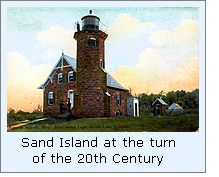 After blasting out a hole for the
cellar, the masons crafted a two-story dwelling, 26' x 30' in plan with
an integrated 44-foot tall tower oriented diagonally into its
northwestern corner. The exterior of the first and second stories of the
tower were approximately ten feet square with buttressed corners, while
the tower's upper portion consisted of a ten-foot octagon. The tower was
double-walled, with a circular inner wall approximately four inches
thick and eight feet in diameter. This cylindrical inner wall supported
a cast iron spiral staircase which wound from two general-purpose areas
and an oil storage room in the cellar to a hatch in the lantern floor.
Since these spiral stairs also served as the only means of moving
between floors in the dwelling, steel doors provided access to landings
on both the first and second floors to prevent the spread of any fire in
either the dwelling or tower. The first floor contained a parlor,
kitchen and two bedrooms, and the second floor two additional bedrooms
and a closet. Almost as an afterthought, a summer kitchen was built in
the form of an addition to the rear of the building. After blasting out a hole for the
cellar, the masons crafted a two-story dwelling, 26' x 30' in plan with
an integrated 44-foot tall tower oriented diagonally into its
northwestern corner. The exterior of the first and second stories of the
tower were approximately ten feet square with buttressed corners, while
the tower's upper portion consisted of a ten-foot octagon. The tower was
double-walled, with a circular inner wall approximately four inches
thick and eight feet in diameter. This cylindrical inner wall supported
a cast iron spiral staircase which wound from two general-purpose areas
and an oil storage room in the cellar to a hatch in the lantern floor.
Since these spiral stairs also served as the only means of moving
between floors in the dwelling, steel doors provided access to landings
on both the first and second floors to prevent the spread of any fire in
either the dwelling or tower. The first floor contained a parlor,
kitchen and two bedrooms, and the second floor two additional bedrooms
and a closet. Almost as an afterthought, a summer kitchen was built in
the form of an addition to the rear of the building.
Atop the tower, the gallery floor was
sheathed with copper, and surrounded by an iron hand-railing to provide
security to keepers when cleaning the plate glass panes in the octagonal
lantern. As construction neared completion, Mr. Crump the District
Lampist arrived and installed the station's fixed white Fourth Order
Fresnel lens, which by virtue of the station's location atop a bluff sat
at a focal plane of 52 feet. Charles Lederle was appointed as Acting
Keeper of the Sand Island Light Station, and arriving at the station on
September 24, 1881 quickly set about moving his belongings into the new
dwelling, exhibiting the light for the first time the following day
evening, September 25, 1881.
The following year, the Lighthouse
Board was considering the installation of steam fog whistles at both
Sand and Raspberry Island, however consideration of the Sand Island fog
signal was dropped, and funds were subsequently only requested for an
installation on Raspberry. On August 25 of this same year, Charles
Lederle was appointed to the position of permanent Keeper of the Sand
Island Light. A work crew arrived on Sand Island in the summer of 1886,
and began work on a boat house and improved crib protection, completing
the project on September 3.
 Although Sand Island was located far
enough from Bayfield to make trips to town in the station's small sail
boat a full day undertaking, life for Lederle was not as isolated as it
was for many keepers of island stations. Sand Island was the only island
in the Apostles chain besides Madeline, to sustain a year-round
population with two distinct settlements. While Shaw Point, the largest
of the two communities, was located at the opposite end of the island,
Camp Stella was situated a short two miles from the lighthouse, and
Lederle was able to interact with the Norwegian farmers and fishermen
who called Camp Stella home. Even so, Lederle likely viewed the news
that he had been offered a transfer to the new station under
construction at Two Harbors as a positive move, since the station was
built within walking distance of the bustling harbor town. Emmanuel
Luick the 1st Assistant at Outer Island was offered the position of
Keeper of the Sand Island Light, arriving on the island with his wife
Ella on January 4, 1892. Although Sand Island was located far
enough from Bayfield to make trips to town in the station's small sail
boat a full day undertaking, life for Lederle was not as isolated as it
was for many keepers of island stations. Sand Island was the only island
in the Apostles chain besides Madeline, to sustain a year-round
population with two distinct settlements. While Shaw Point, the largest
of the two communities, was located at the opposite end of the island,
Camp Stella was situated a short two miles from the lighthouse, and
Lederle was able to interact with the Norwegian farmers and fishermen
who called Camp Stella home. Even so, Lederle likely viewed the news
that he had been offered a transfer to the new station under
construction at Two Harbors as a positive move, since the station was
built within walking distance of the bustling harbor town. Emmanuel
Luick the 1st Assistant at Outer Island was offered the position of
Keeper of the Sand Island Light, arriving on the island with his wife
Ella on January 4, 1892.
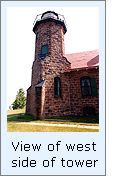 Life at Sand Island appears to have
been relatively uneventful for the Luicks through the end of the century
until Emmanuel fell seriously ill in 1901. Completely bed-ridden, and
without the benefit of an assistant to fill in for him, there was no
alternative but for Ella to assume his responsibilities for the three
weeks of his illness. From all accounts Ella did a landmark job. However
the incident pointed out the potential problems associated with having a
single keeper at such a remote station, and Eleventh District Inspector
Commander J. C. Wilson authorized the addition of an Assistant Keeper at
Sand Island at the opening of the following season of navigation. Henry
A Irvine was hired to fill the position, and reported for duty on May
22, 1902. Soon thereafter, a work crew arrived on the island and
replaced the stone-filled dock protection cribs, constructed a 16 foot
long walkway up the bluff from the dock to the station, and built a 360
gallon capacity oil storage building. Life at Sand Island appears to have
been relatively uneventful for the Luicks through the end of the century
until Emmanuel fell seriously ill in 1901. Completely bed-ridden, and
without the benefit of an assistant to fill in for him, there was no
alternative but for Ella to assume his responsibilities for the three
weeks of his illness. From all accounts Ella did a landmark job. However
the incident pointed out the potential problems associated with having a
single keeper at such a remote station, and Eleventh District Inspector
Commander J. C. Wilson authorized the addition of an Assistant Keeper at
Sand Island at the opening of the following season of navigation. Henry
A Irvine was hired to fill the position, and reported for duty on May
22, 1902. Soon thereafter, a work crew arrived on the island and
replaced the stone-filled dock protection cribs, constructed a 16 foot
long walkway up the bluff from the dock to the station, and built a 360
gallon capacity oil storage building.
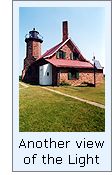 Henry Irvine's stay at Sand Island was
relatively short, as he was transferred to Devils Island on October 10,
1903. With Irvine's replacement yet to arrive at the station, Emmanuel
appointed Ella as his Acting Assistant. However, Ella's official
appointment was short-lived as the newly hired Edward Derry reported for
duty the following day. Ella would serve again as Acting Assistant for
ten days the following year, after Derry resigned without notice on
April 30, 1904. Although all external appearances indicated that Ella
was ideally suited to life as the wife of a light keeper and that their
marriage was built on a strong foundation, there were evidently unseen
forces tearing at their relationship. After ten years on the island,
Ella boarded the steamer BARKER on May 9, 1905, never to return to
either Sand Island or her husband. Henry Irvine's stay at Sand Island was
relatively short, as he was transferred to Devils Island on October 10,
1903. With Irvine's replacement yet to arrive at the station, Emmanuel
appointed Ella as his Acting Assistant. However, Ella's official
appointment was short-lived as the newly hired Edward Derry reported for
duty the following day. Ella would serve again as Acting Assistant for
ten days the following year, after Derry resigned without notice on
April 30, 1904. Although all external appearances indicated that Ella
was ideally suited to life as the wife of a light keeper and that their
marriage was built on a strong foundation, there were evidently unseen
forces tearing at their relationship. After ten years on the island,
Ella boarded the steamer BARKER on May 9, 1905, never to return to
either Sand Island or her husband.
 Later that year, on September 2, 1905,
Sand Island's only major shipwreck occurred. Seeking shelter among the
islands from the biggest blow in thirty years, the 372- foot bulk
steamer SEVONA struck a shoal to the northeast of Sand Island. As the
vessel split in two and began breaking-up, the Chief Engineer in the
rear section gave the order to lower the life boats and abandon ship.
Eleven crew members and passengers were loaded into two life boats,
barely making it to shore through the immense waves crashing over the
wreckage. Without the benefit of a life boat in the forward section of
the vessel, the ship's Captain and six crew members attempted to make it
to shore clinging to one of the vessel's hatch cover. However, unable to
cling on to their makeshift raft in the huge seas, all seven perished in
Superior's perpetually frigid waters. Click here
to view an account of the story of the
SEVONA wreck as it appeared in contemporary newspapers on the Apostle Islands National Lakeshore website. Later that year, on September 2, 1905,
Sand Island's only major shipwreck occurred. Seeking shelter among the
islands from the biggest blow in thirty years, the 372- foot bulk
steamer SEVONA struck a shoal to the northeast of Sand Island. As the
vessel split in two and began breaking-up, the Chief Engineer in the
rear section gave the order to lower the life boats and abandon ship.
Eleven crew members and passengers were loaded into two life boats,
barely making it to shore through the immense waves crashing over the
wreckage. Without the benefit of a life boat in the forward section of
the vessel, the ship's Captain and six crew members attempted to make it
to shore clinging to one of the vessel's hatch cover. However, unable to
cling on to their makeshift raft in the huge seas, all seven perished in
Superior's perpetually frigid waters. Click here
to view an account of the story of the
SEVONA wreck as it appeared in contemporary newspapers on the Apostle Islands National Lakeshore website.
Luick found a second wife, Oramill, and
with her support continued to serve as Keeper of the Sand Island light
for the following sixteen years. Whether Luick was a good trainer, or
just plain difficult to work with is as yet unknown, however over those
sixteen years he went through twelve Assistants, with the longest tenure
of any of them being only two years, and seven of them resigning from
the service.
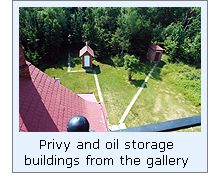 By the end of the second decade of the
twenty-first century, shipping patterns in Superior had changed
dramatically, and with fewer vessels heading into Bayfield and Ashland
from the west, the importance of the Sand Island Light waned. Concurrent
to this change, advances in the use of automated acetylene lighting had
allowed the Lighthouse Bureau to successfully automate a number of
stations. With such systems being able to operate without human
intervention for months at a time the decision was made to install an
acetylene system at Sand Island. Effectively eliminating the expense of
a resident keeper and assistant, observation and maintenance of the
automated light would be added to the list of responsibilities of the
keepers at Raspberry Island. By the end of the second decade of the
twenty-first century, shipping patterns in Superior had changed
dramatically, and with fewer vessels heading into Bayfield and Ashland
from the west, the importance of the Sand Island Light waned. Concurrent
to this change, advances in the use of automated acetylene lighting had
allowed the Lighthouse Bureau to successfully automate a number of
stations. With such systems being able to operate without human
intervention for months at a time the decision was made to install an
acetylene system at Sand Island. Effectively eliminating the expense of
a resident keeper and assistant, observation and maintenance of the
automated light would be added to the list of responsibilities of the
keepers at Raspberry Island.
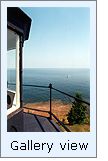 A 375 mm lens lantern with a
750-candlepower acetylene illumination system was installed atop a 48
foot steel skeletal tower, and exhibited for the first time on the
evening of April 23, 1921. In order to conserve fuel, the characteristic
of the light was changed from fixed to flashing, with a repeated cycle
consisting of a 1.5 second flash followed by 8.5 seconds of
darkness. A 375 mm lens lantern with a
750-candlepower acetylene illumination system was installed atop a 48
foot steel skeletal tower, and exhibited for the first time on the
evening of April 23, 1921. In order to conserve fuel, the characteristic
of the light was changed from fixed to flashing, with a repeated cycle
consisting of a 1.5 second flash followed by 8.5 seconds of
darkness.
With the activation of the automated
light, Emmanuel Luick accepted a transfer to the Grand Marais, Minnesota
light station after a remarkably long twenty-nine years of service at
Sand Island. Luick continued to serve at Grand Marais until he retired
from lighthouse service in 1937 at 71 years of age, passing away 10
years thereafter.

Keepers of
this Light

Click here to see a complete listing of all
Sand Island Light keepers compiled by
Phyllis L. Tag of Great Lakes Lighthouse Research.

Seeing this Light

For five
days in July, 2002, we were privileged to serve as NPS volunteers,
assisting Park Historian Bob Mackreth in documenting the condition of
all the Apostle Islands Lights. We first attempted a landing on the
morning of Thursday July 18, but with a relatively strong northeaster
pushing three to four footers across the lake, we could neither put in
against the rocks in front of the station or at the dock in Sand Bay two
miles to the south. However, we did make a close pass by the station,
and managed to take the photograph of the waves breaking on the rocks
seen at the top of this page.
We returned late the following
morning, and while the water was not smooth enough to allow us to tie up
against the rocks in front of the station, the pilot was able to bring
the nose of the boat close to the rocks, allowing us to jump off the bow
onto the rocks.
This station had never
served as quarters for any coast guardsmen, and thus it had managed to
escape the standard "white, gray and safety yellow" paint
scheme throughout its interior. As a result, we were surprised at the
comfortable and homey atmosphere the building exuded.
After our pilot brought the boat's bow back toward the rocks, we jumped
back aboard, and made a close pass by Sand Island's sea coves as we
headed back to the mainland.

Finding this Light

While
all of the Apostle Island Lights are open for visitation during the
summer season, a private boat is needed to make landfall at Sand Island
for all but two weeks of the year. While Apostle
Island Cruise Service offers daily trips around the islands,
passing close to Sand Island for photography, it is only during the two
weeks of the annual Keeper of The Light festival in September that they
offer landings on Sand Island.

Contact information

Apostle Island Cruise Services may be
contacted at the following address:
Apostle Island Cruise Services may be contacted at the following address:
P.O. Box 691 - City Dock
Bayfield, WI 54814
Telephone: (800) 323-7619
Email: info@apostleisland.com
For information on the Keeper
Of The Light Celebration, contact:
PO Box 990 19 Front St.
Bayfield, WI 54814
Telephone: (800) 779-4487

Historical
references

Annual reports of the lighthouse Board, various, 1859 - 1909
Annual reports of the Lighthouse Service, various, 1910 - 1953
Great Lakes Light Lists, various, 1876 - 1977
Annual reports of the Lake Carrier's Association, various, 1906 -
1940
Photograph courtesy of
Photographs taken by the author in July, 2002.
Historic and recent photographs courtesy of the Apostle Island Lakeshore.
Email correspondence with Bob Mackreth NPS, various, January &
February 2002
|
